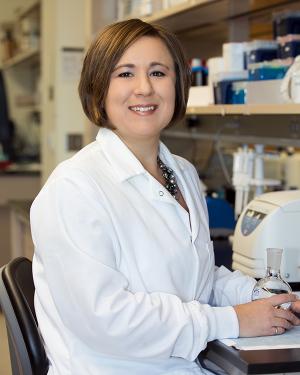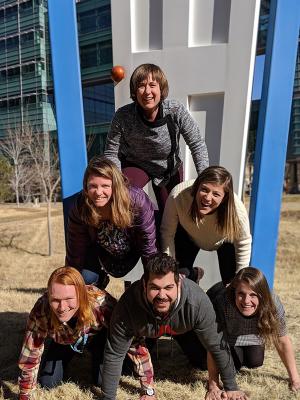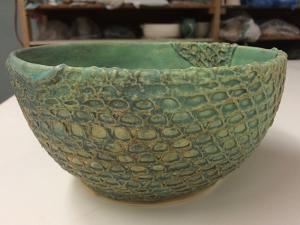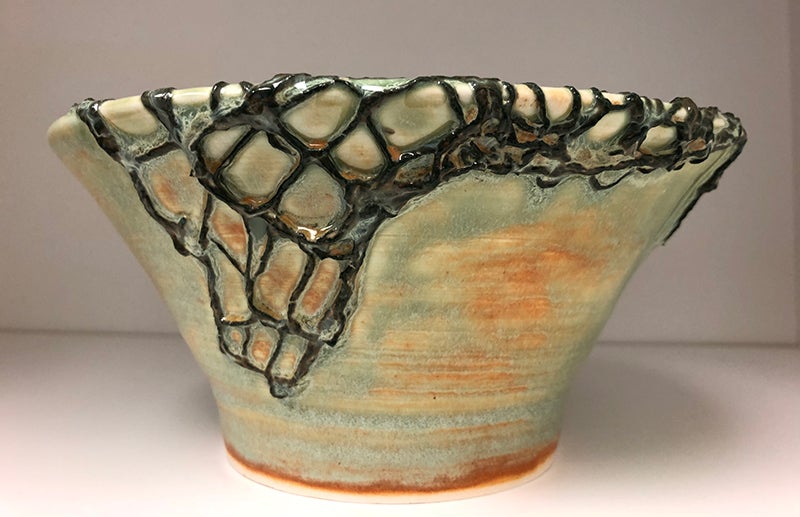Five questions for Chelsea Magin
For decades, the Petri dish has been used to culture cells and learn more about disease. What would happen if a Petri dish was no longer needed because human tissue could be replicated? Would new results advance biomedical research?
That question is what Chelsea Magin and her team are working on, developing cell culture platforms that mimic lung tissue.
Magin is an assistant professor and the principal investigator of the Bio-Inspired Pulmonary Engineering Lab at the CU Anschutz Medical Campus. She earned her Ph.D. in biomedical engineering from the University of Florida.
“I wanted to be a faculty member. I was passionate about it,” Magin said. “I worked on my postdoctoral research with a famous woman at CU Boulder, Kristi Anseth. I was excited because there aren’t that many female role models in engineering yet. Her lab is well known for what they do, and I was excited to get that experience.”
As Magin likes to remind the many people she mentors and trains, the pathway to personal success isn’t always linear.
“Even if it is your passion, you might have to work harder than you expect to get where you want to go,” she said.
After working at the Anseth lab for a few years, she interviewed for faculty positions but wasn’t hired. Discouraged, but wanting to remain in Colorado, she looked to the broader biomedical industry. She worked for the startup Sharklet Technologies, moving up through the ranks to eventually become the director of product development.
“A big part of my role was inventing new ideas for products, writing grants and getting funding so we could do the research, running a team of people who did the research on the benchtop, and writing publications. I loved it,” she said.
But as the company began to grow, the job became more about paperwork and less about what she enjoyed. She looked toward academia once more. For one semester, she was an adjunct at CU Denver, taking on a class with “70 students with no teaching assistant. It was gigantic and five credit hours and I was still working 75 percent at Sharklet.”
In 2017, she applied for the position she currently holds with her primary appointment in medicine and her secondary appointment in bioengineering.
“We’ve had 16 people work in the lab so far. Eight have been undergraduate researchers, three people have gotten their master’s degrees, one has been an M.D. fellow, and two are currently conducting Ph.D. research,” she said. “Nine were women and seven are people of color: I’m excited that my lab has been able to promote diversity through who we are and who we represent.”
She recently spent Christmas break on a trip to Antarctica.
“The trip is sponsored by Natural Habitats, so it featured scientists on the ship – ecologists and naturalists and marine biologists and even National Geographic photographers with us,” she said. “It really means a lot to me that this tourism also supports scientific discovery.”
1. How did you choose this career path?
My father is an electrical engineer and he would take me to Bring Your Daughter to Work Day at his company. We spent a lot of time doing science projects for fun when I was growing up. In the third grade, we built an electromagnet. I brought it to school and showed everybody and thought it was the coolest thing ever. I grew up knowing what engineers do and was excited about science.
There were roadblocks for me as a female in the field, but I think, in general, it is getting better, and, especially in bioengineering, we are starting to get equal numbers of females enrolling in classes. We are trying to continue to build that pipeline.
I am passionate about diversity and inclusion and there are a couple of different things I’ve worked on to help. In addition to being a women in engineering, I’m a first-generation college student. My dad was an electrical engineer but he did not have a college degree. I had the opportunity through the leadership program Impact Denver to work with a team that started a yearly event called “Ready, Set, College!” We invite as many first-generation college students as we can support. There are speakers who teach these students the basics of finance, time management, scholarships and how to work with financial aid departments at universities. We have a partner, PCs for People, that helps us donate a laptop to each one of these kids to get them going. Most of these students tend to be underrepresented in their field so it is really rewarding to help create a pipeline for more diversity and inclusion. It’s been an amazing experience.
The other thing I’m excited about is a collaboration with a small company in Denver called Couragion. They make an app that helps teach students about STEM careers with videos of role models and scenarios of their everyday work. I’ve worked with Couragion to be a virtual mentor, creating biotechnology content to help get students interested in the field.
2. Your lab is developing bioengineered lung models to allow researchers to study disease and regeneration. How are these models developed and will they allow study of a variety of diseases?
When I started my faculty position here in April 2017, I focused on lung research even though I had never worked with pulmonary medicine before. One of the cool things we do with materials is study the properties of the tissue, including how soft or stiff it is, what it is made of and the shape of it, all the way down to a micro scale.
My lab takes that information and builds synthetic materials that mimic those microenvironments. Our goal is to be able to put human cells in these models to better test the mechanisms of disease or find new treatments for diseases. Our models could induce different responses in cells that would occur in their natural environment. In essence, these are perfect microenvironments to mimic lung tissue. There are other labs interested in this type of work, but there aren’t many doing this with lungs.
One of my collaborators is Darcy Wagner at Lund University in Sweden. She has been taking the cells out of lungs and then using the remaining extracellular proteins to make natural materials. We call it decellularized extracellular matrix. We combine my synthetic materials with her natural materials to make a hybrid: This gives us the chemical cues of natural materials and control over mechanical properties. When we build models like this, it can be a platform technology that we can apply to study many different types of diseases.
We are specifically trying to build lung or blood vessel tissue, so our work impacts diseases specific to lungs or blood vessels. We have focused on idiopathic pulmonary fibrosis, a lung-scarring disease that is studied and treated extensively at the University of Colorado and our affiliate institution, National Jewish Health. During this disease, cells remodel the extracellular matrix, which further drives disease progression. This remodeling stiffens the tissue, hence our efforts to create biomaterials that model stiffening better than traditional techniques. We have received a Department of Defense grant to study pulmonary fibrosis in veterans. One of the main reasons the military is interested in this is because veterans from Iraq and Afghanistan have higher rates of the disease than the civilian population. I’m excited about this work so that we can help our servicemen and women, and also translate these results to patients worldwide.
Extracellular matrix remodeling is also a hallmark of pulmonary hypertension, which our lab has begun studying. One of the things I find interesting about pulmonary arterial hypertension is that four times more women get this disease than men; we recently received funding from the Center for Women’s Health Research and Rose Community Foundation for this research. Our lab uses 3D printing to make blood vessels that can contain female or male cells, allowing us to study how the cells respond differently for insight into sex differences and improved treatments.
3. Is your lab working on other projects?
We have started a collaboration with Meredith Tennis, an assistant professor at the School of Medicine, to engineer ex vivo models of lung cancer. Our lab has invented a material that can be wrapped around very thin slices of lung tissue to keep these tissues alive outside the body for a long period of time. We published a paper in the American Journal of Respiratory Cellular and Molecular Biology showing that this material keeps the tissue alive for at least 21 days, three times longer than previous experiments. We’re using that material and the embedding process to induce cancerous lesions outside the body to study cancer progression and treatment.
Many end-stage lung diseases have no cure. While lung transplantation is an option, the demand far outweighs the supply. Thus, I spend a lot of time thinking about how to regenerate or build a new set of lungs. This is the next frontier for our lab because the lung is such a complicated organ, perhaps the most complex one we have.
4. Recently, you were named Educator of the Year by the Colorado Bioscience Association (CBSA) for work in your lab but also for being a mentor. What did you learn while being a mentor?
I’ve been an active member of the CBSA, a trade organization for local bioscience companies, since I moved to Colorado seven years ago. The educational mission of CBSA includes training students and teachers in the field. I was passionate about education when I worked at Sharklet as director of product development so we participated in the Research Experience for Teachers program as a host organization. The program provides middle-school science and math teachers with externship experience, working at a business for a few weeks to learn how science is conducted in industry and what these companies look for when hiring STEM students. Teachers then bring that knowledge back to their classrooms.
One outstanding teacher, Mandi Ruud Singleton, worked on my team to study how stem cells responded to Sharklet micropatterns on surfaces. She had such a great time that she extended her externship, taking up two extra weeks of her summer break to finish the project. This work turned into an abstract that we presented to the World Biomaterials Congress in Montreal.
Two years later in the very first class I taught – Engineering General Chemistry, with 70 students and no teaching assistant – I knew I needed to assign some group projects. I immediately called Mandi, who taught me how to implement problem-based learning techniques to create group assignments in the classroom. She suggested using real-world problems as the basis for the assignment and I found one that I thought students would thoroughly enjoy.
Did you know that when astronauts are wearing their launch and re-entry suits, they don’t have a way to go to the bathroom? NASA decided that this was unacceptable and put out a call for innovative ideas for dealing with human waste in space. I thought this “space poop challenge” was perfect and directed my students to use chemistry and engineering principles to solve the problem. My students not only invented novel ways to deal with space poop, but also got to talk to scientists from NASA as well as the finalists from the real challenge. This quick introduction to a new pedagogy technique from Mandi made it all happen.
I get a lot of joy out of seeing people learning new things and helping them overcome challenges that I’ve experienced myself. I really get excited about helping to create the next generation of scientists and engineers.
5. What are hobbies or activities you enjoy outside of work?
I like to throw pottery. There was a faculty art exhibit at the Strauss Health Sciences Library on campus and couple of my bowls were in it. I started throwing pottery back in college. I spent a long time making functional things. I’m an engineer so I thought, “I want to make a cup and a bowl and a plate.” More recently, I’ve been trying to make art. One of the things I’ve been doing is mixed media. I knit a lace fabric and I incorporate the fabric into the clay itself to make texture or add it to the pottery afterwards. I also love road biking and I like to hike and backpack around Colorado. I’m from Florida so I am not a good skier.





